Bias-Correcting the Maximum and Minimum Air Temperatures of Egypt Using a High-Resolution Regional Climate Model (RegCM4) †
Abstract
1. Introduction
- Examine the spatial pattern of the Tmax and Tmin of Egypt in the reference period (1985–2005; RF), as well as under the extreme future scenario (RCP8.5).
- Evaluate and bias-correct the RegCM4 output in comparison with station observations of the RF.
- Correct the RCP8.5 future scenario at the locations where the bias-correction shows its potential skills.
2. Materials and Methods
2.1. Study Area
2.2. Experiment Design
2.3. Validation Data
3. Results
3.1. Projecting the Maximum and Minimum Air Temperatures under the RCP8.5 Scenario
3.2. Evaluating the RegCM4 with Respect to Station Observations
3.3. Correcting the Future Probability of Occurrence
4. Discussion and Conclusions
Supplementary Materials
Author Contributions
Funding
Institutional Review Board Statement
Informed Consent Statement
Data Availability Statement
Acknowledgments
Conflicts of Interest
References
- Stocker, T.F.; Qin, D.; Plattner, G.-K.; Tignor, M.; Allen, S.K.; Boschung, J.; Nauels, A.; Xia, Y.; Bex, V.; Midgley, P.M. (Eds.) IPCC 2013: Climate Change 2013: The Physical Science Basis; Contribution of Working Group I to the Fifth Assessment Report of the Intergovernmental Panel on Climate Change; Cambridge University Press: Cambridge, UK; New York, NY, USA, 2013; 1535p. [Google Scholar]
- Almazroui, M.; Saeed, F.; Saeed, S.; Nazrul Islam, M.; Ismail, M.; Klutse NA, B.; Siddiqui, M.H. Projected change in temperature and precipitation over Africa from CMIP6. Earth Syst. Environ. 2020, 4, 455–475. [Google Scholar] [CrossRef]
- Driouech, F.; ElRhaz, K.; Moufouma-Okia, W.; Arjdal, K.; Balhane, S. Assessing Future Changes of Climate Extreme Events in the CORDEX-MENA Region Using Regional Climate Model ALADIN-Climate. Earth Syst. Environ. 2020, 4, 477–492. [Google Scholar] [CrossRef]
- Nashwan, M.S.; Shahid, S.; Chung, E.S. High-Resolution Climate Projections for a Densely Populated Mediterranean Region. Sustainability 2020, 12, 3684. [Google Scholar] [CrossRef]
- Anwar, S.A.; Salah, Z.; Khald, W.; Zakey, A.S. Projecting the Potential Evapotranspiration of Egypt Using a High-Resolution Regional Climate Model (RegCM4). Environ. Sci. Proc. 2022, 19, 43. [Google Scholar] [CrossRef]
- Lafon, T.; Dadson, S.; Buys, G.; Prudhomme, C. Bias correction of daily precipitation simulated by a regional climate model: A comparison of methods. Int. J. Climatol. 2013, 33, 1367–1381. [Google Scholar] [CrossRef]
- Xu, X.; Huang, A.; Huang, Q.; Zhang, Y.; Wu, Y.; Gu, C.; Cai, S.; Zhu, X. Impacts of horizontal resolution of the lateral boundary conditions and downscaling method on the performance of RegCM4.6 in simulating the surface climate over central-eastern China. Earth Space Sci. 2022, 9, e2022EA002433. [Google Scholar] [CrossRef]
- Taylor, K.E.; Stouffer, R.J.; Meehl, G.A. An Overview of CMIP5 and the experiment design. Bull. Am. Meteor. Soc. 2012, 93, 485–498. [Google Scholar] [CrossRef]
- Li, S.; Lü, S.; Gaoa, Y.; Ao, Y. The change of climate and terrestrial carbon cycle over Tibetan Plateau in CMIP5 models. Int. J. Climatol. 2015, 35, 4359–4369. [Google Scholar] [CrossRef]
- Eyring, V.; Bony, S.; Meehl, G.A.; Senior, C.A.; Stevens, B.; Stouffer, R.J.; Taylor, K.E. Overview of the Coupled Model Intercomparison Project Phase 6 (CMIP6) experimental design and organization. Geosci. Model Dev. 2016, 9, 1937–1958. [Google Scholar] [CrossRef]
- Gado, T.A.; Mohameden, M.B.; Rashwan, I.M.H. Bias correction of regional climate model simulations for the impact assessment of the climate change in Egypt. Environ. Sci. Pollut. Res. 2021, 29, 20200. [Google Scholar] [CrossRef] [PubMed]
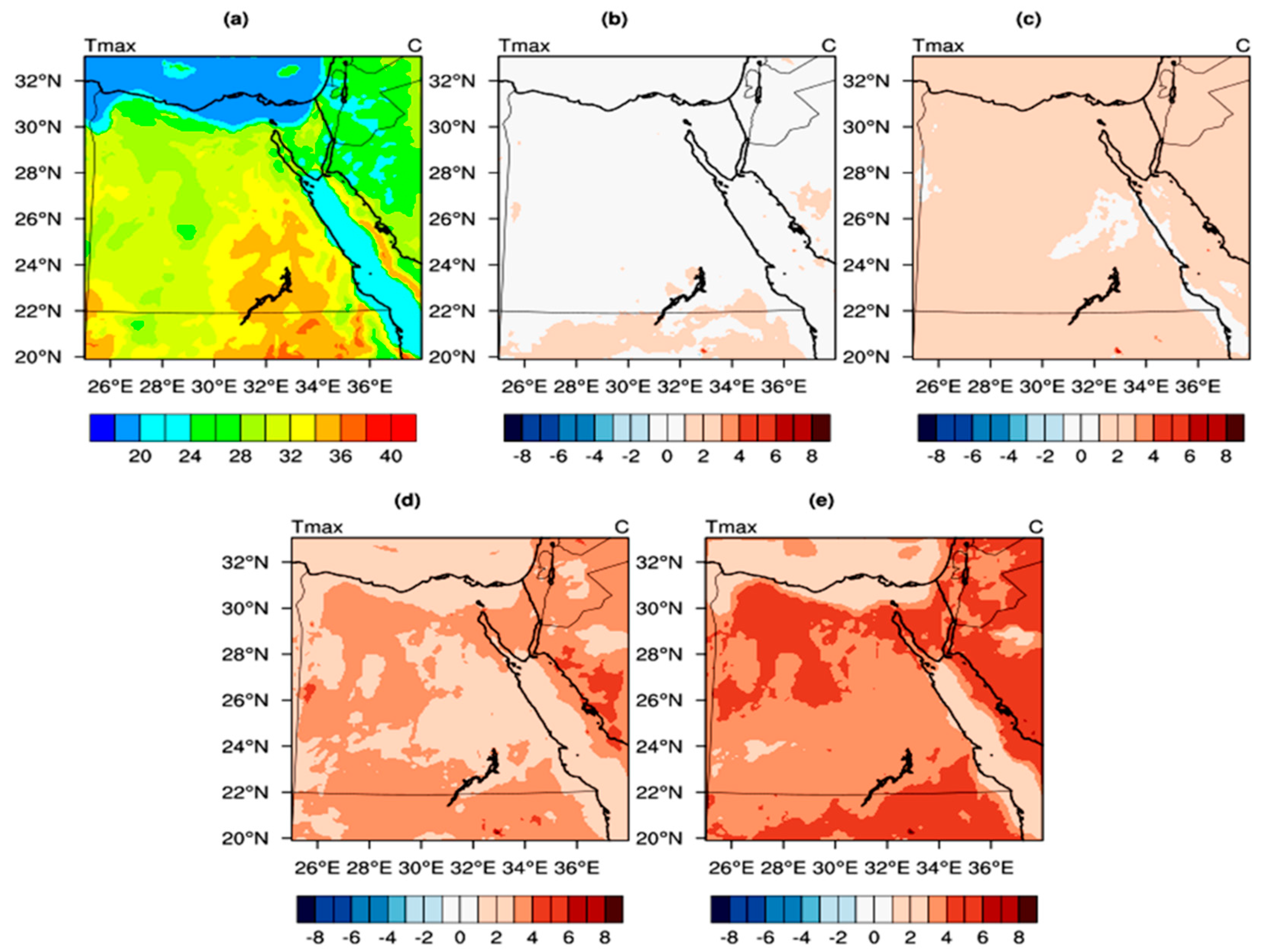
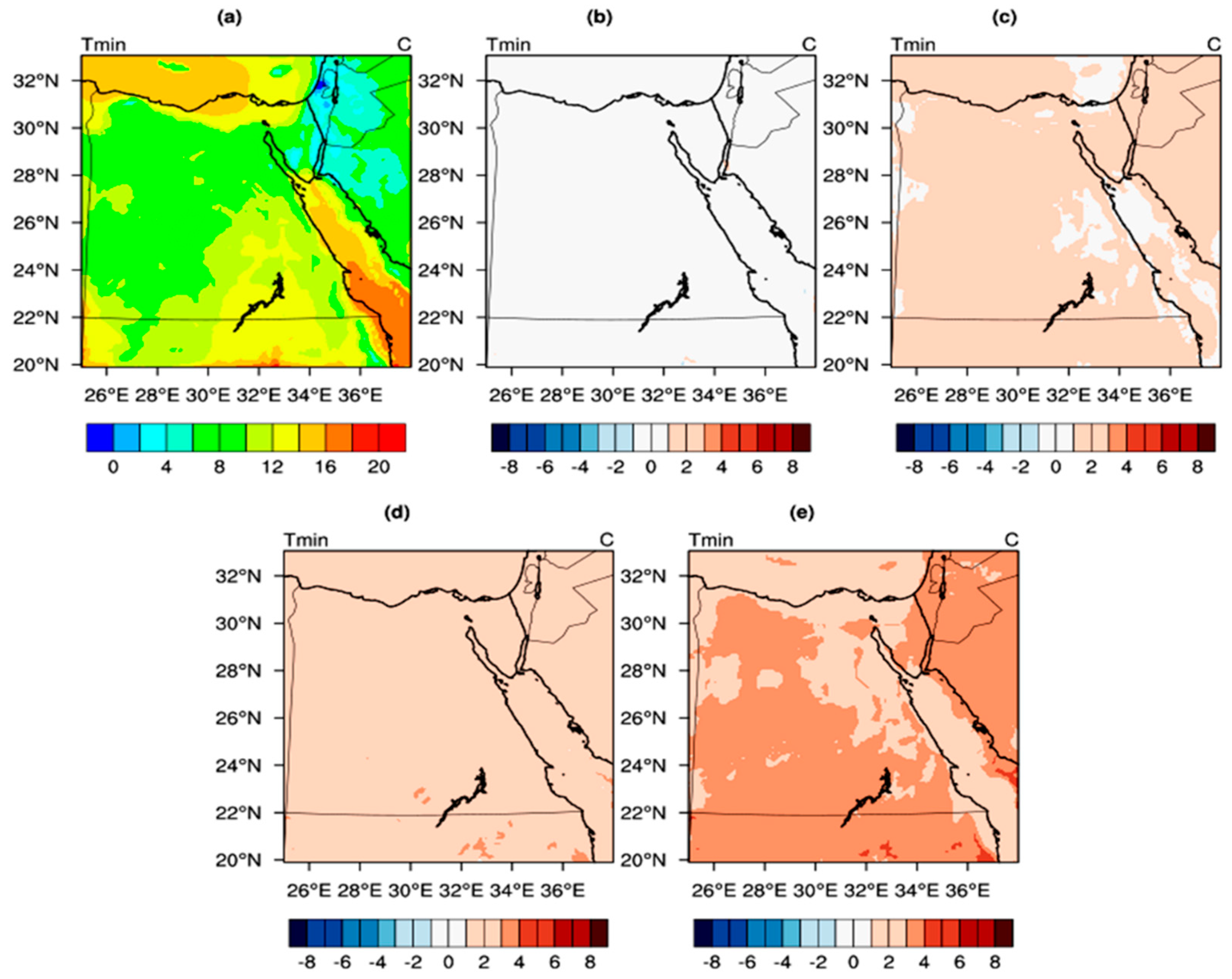
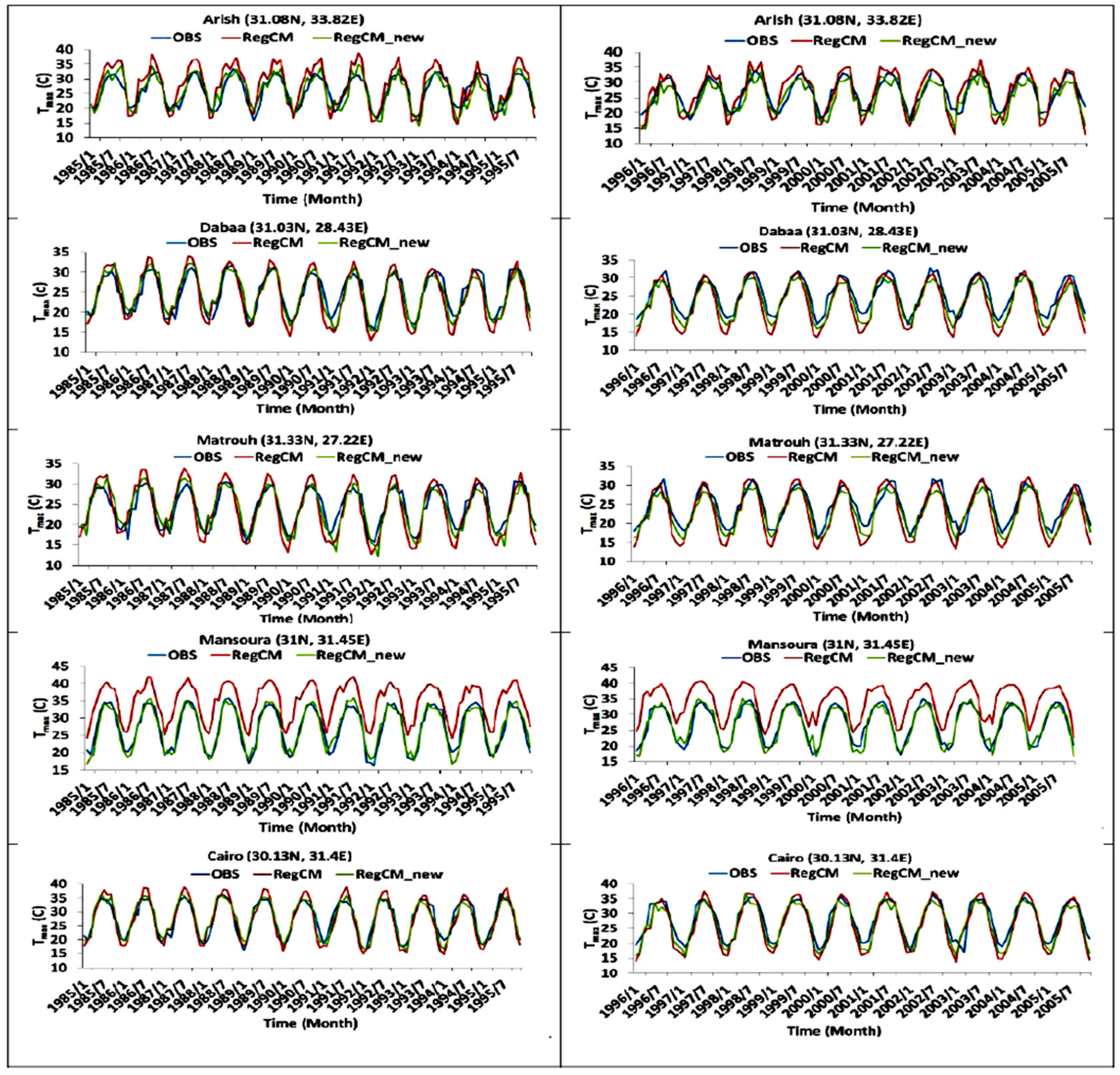
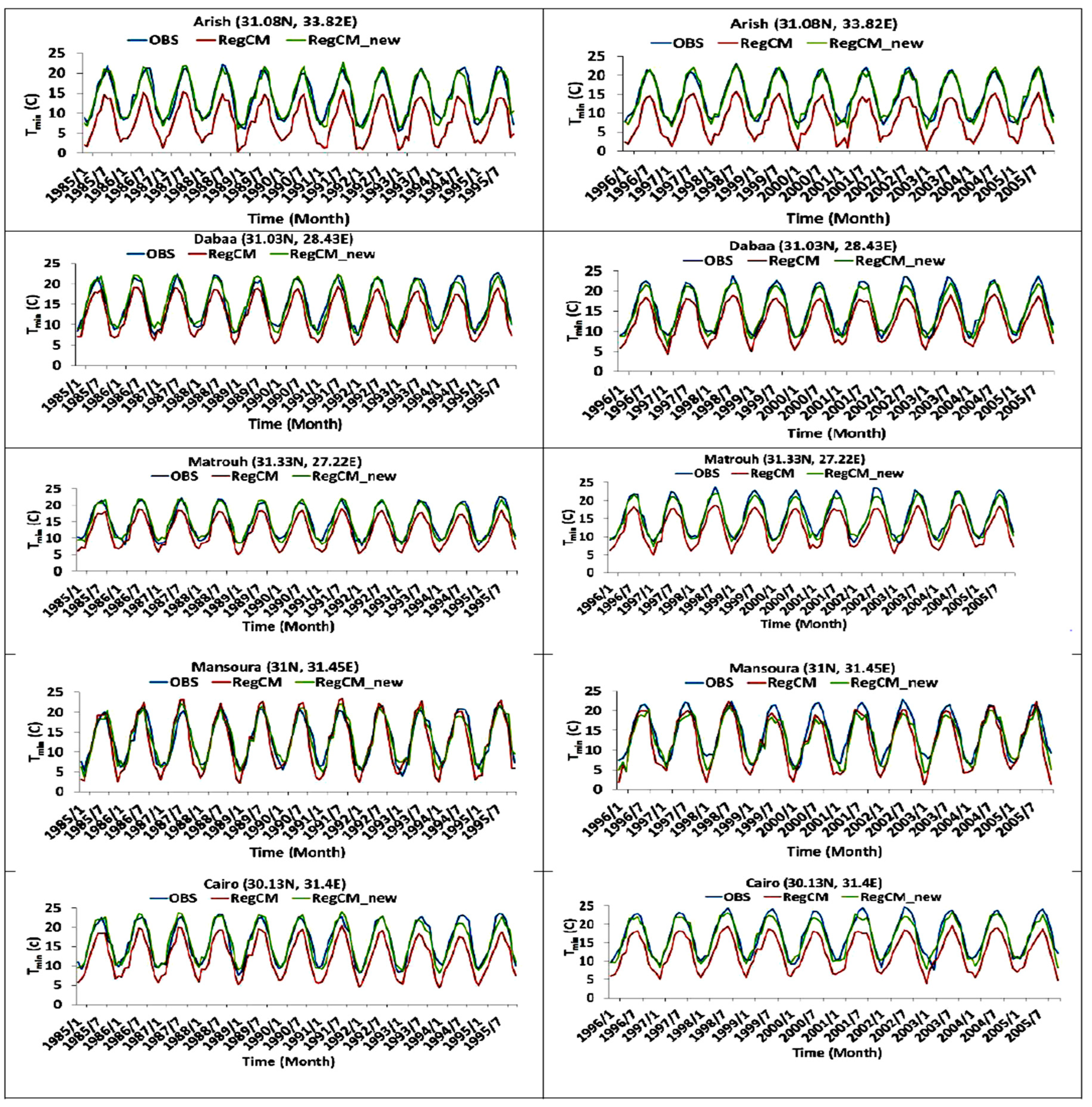
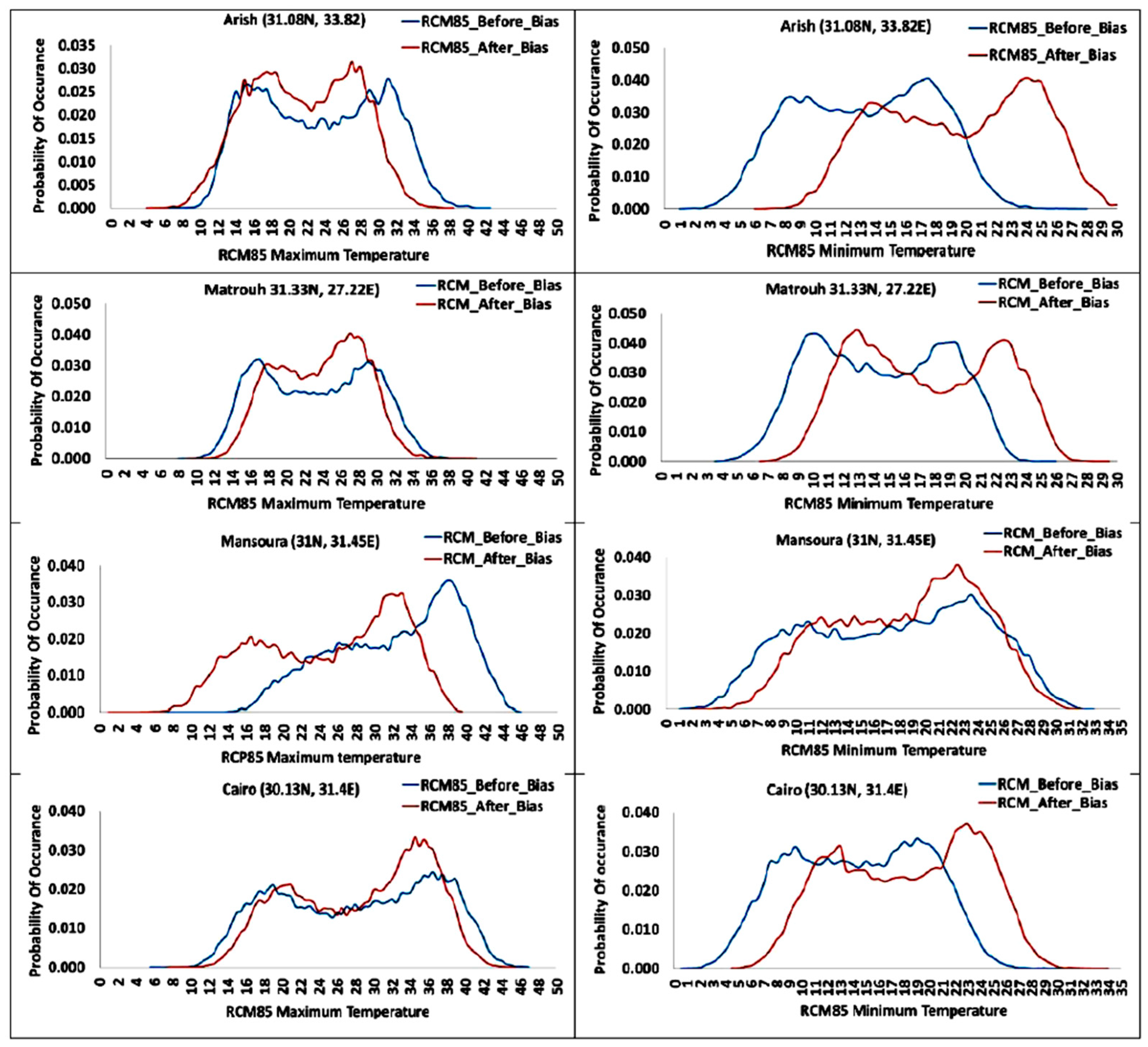
| Station Name | Lat | Lon | Elevation (m) | Lat | Lon | Elevation (m) |
|---|---|---|---|---|---|---|
| Arish | 31.08° | 33.82° | 30.57 | Hurgada | 27.18° | 33.80° |
| Dabaa | 31.03° | 28.43° | 17 | Sharm | 27.98° | 34.38° |
| Marsa Matrouh | 31.33° | 27.22° | 25 | Kossir | 26.18° | 34.25° |
| Mansoura | 31° | 31.45° | 3.73 | Assyut | 27.5° | 31.16° |
| Cairo | 30.13° | 31.40° | 64.12 | Asswan | 23.97° | 32.78° |
| Farafra | 27.05° | 27.98° | 77.79 | |||
Disclaimer/Publisher’s Note: The statements, opinions and data contained in all publications are solely those of the individual author(s) and contributor(s) and not of MDPI and/or the editor(s). MDPI and/or the editor(s) disclaim responsibility for any injury to people or property resulting from any ideas, methods, instructions or products referred to in the content. |
© 2022 by the authors. Licensee MDPI, Basel, Switzerland. This article is an open access article distributed under the terms and conditions of the Creative Commons Attribution (CC BY) license (https://creativecommons.org/licenses/by/4.0/).
Share and Cite
Mostafa, S.M.; Anwar, S.A.; Zakey, A.S.; Wahab, M.M.A. Bias-Correcting the Maximum and Minimum Air Temperatures of Egypt Using a High-Resolution Regional Climate Model (RegCM4). Eng. Proc. 2023, 31, 73. https://doi.org/10.3390/ASEC2022-13852
Mostafa SM, Anwar SA, Zakey AS, Wahab MMA. Bias-Correcting the Maximum and Minimum Air Temperatures of Egypt Using a High-Resolution Regional Climate Model (RegCM4). Engineering Proceedings. 2023; 31(1):73. https://doi.org/10.3390/ASEC2022-13852
Chicago/Turabian StyleMostafa, Sally Mahmoud, Samy Ashraf Anwar, Ashraf Saber Zakey, and Mohamed Magdy Abdel Wahab. 2023. "Bias-Correcting the Maximum and Minimum Air Temperatures of Egypt Using a High-Resolution Regional Climate Model (RegCM4)" Engineering Proceedings 31, no. 1: 73. https://doi.org/10.3390/ASEC2022-13852
APA StyleMostafa, S. M., Anwar, S. A., Zakey, A. S., & Wahab, M. M. A. (2023). Bias-Correcting the Maximum and Minimum Air Temperatures of Egypt Using a High-Resolution Regional Climate Model (RegCM4). Engineering Proceedings, 31(1), 73. https://doi.org/10.3390/ASEC2022-13852







